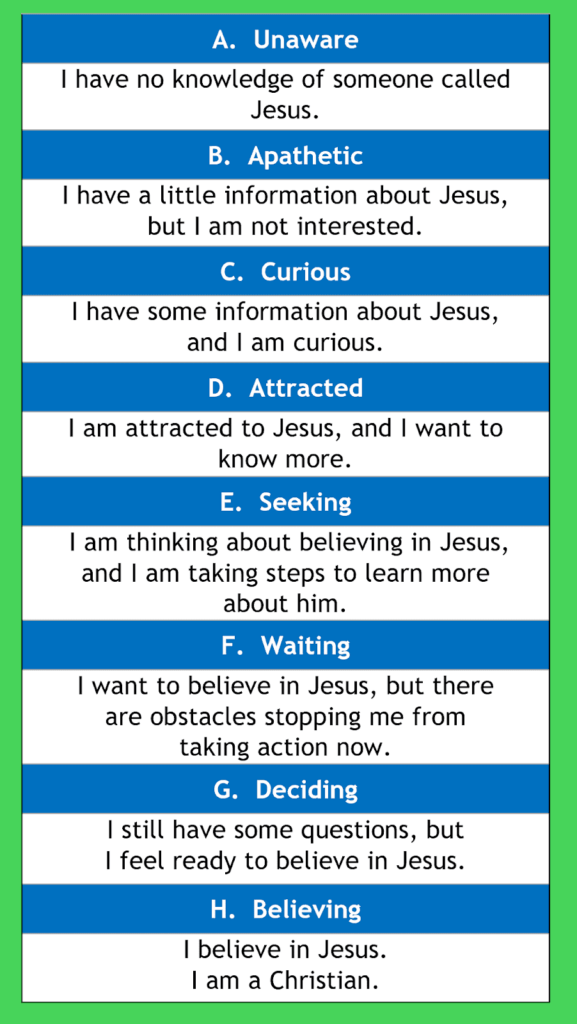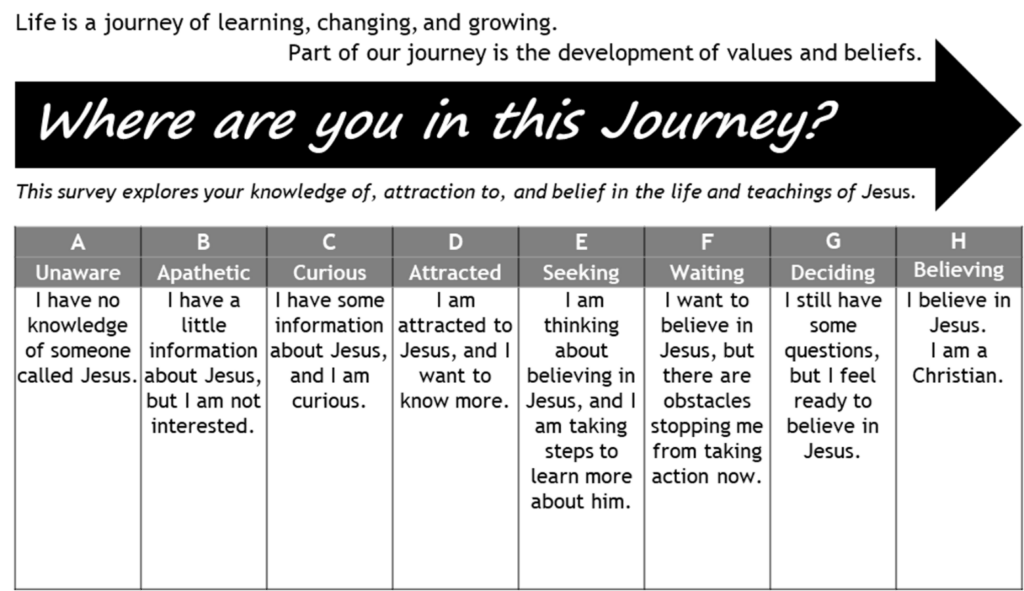The Journey: A Tool For Sharing Christ by James Loftin

When we hear the word evangelism, most of us think of the ways people communicate the saving message of Jesus. Witnessing and preaching are two biblical and effective methods of evangelism. In an earlier article, I introduced a tool for this type of ministry – Words That Shine: Creating a Verbal Witness that is Effective Anywhere. If our churches were filled with disciples who were competent and confident in sharing this type of witness, we would have far more baptisms, celebrate more transformations, and send out more missionaries to the darkest corners of the earth.
The Power of Questions and Listening in Evangelism
But the art of asking good questions and listening is also a vitally important approach to evangelism. Jesus was a superb teacher and prophet. He asks over 300 questions in the four Gospels. He realized the power of asking good questions and listening well. In Luke 24:13-35, we find the fascinating interaction between the resurrected Jesus and two men walking from Jerusalem to Emmaus. Cleopas and his friend had been following Jesus, but the crucifixion and the missing body of Jesus had rocked their world and challenged their hopes. Their hearts were heavy with disappointment. As they walked away from Jerusalem, they walked away from the other Christ followers. Perhaps they were also walking away from their faith. They may have been doing what we might call deconstructing their faith. They thought they were walking alone.
But Jesus saw and heard them.
At some point, he physically joined them, although without them realizing who he was. As they walked together, Jesus asked them a question – and then another and then another. Only after listening to the comments of Cleopas and his buddy, did Jesus respond (Note that his comments were directly related to their voiced concerns). Jesus had much more he could have shared, but he stopped. He gave them the opportunity to end the discussion for the day. They chose to keep talking and their lives were changed. The resurrected Jesus used good questions and active listening to communicate life and salvation to Cleopas and his friend. As Christ followers in the twenty-first century, we should spend as much time developing our listening ministry as we do improving our ability to speak.
Introducing The Journey: A Practical Evangelism Tool
Over the past two decades, the core of my ministry has involved coaching, writing, and creating ministry tools to help families and churches more effectively share the Good News. One of these tools is The Journey. It involves the art of asking good questions and listening well. Churches, international student ministries, and missionaries are using it for God’s glory in China and across the USA.
The development of this evangelism tool began during my dissertation research on the paths people take to begin following Jesus. Over the past century, dozens of sociologists, psychologists, and missiologists – including William James, James Engel, and Bill Bright – have tried to explain the process of conversion. Many created charts to illustrate their understanding of the process. In 2008, I created a cross-cultural version, The Loftin Conversion Scale, which relies heavily on the work of James Engel. I later realized that the scale could be more than a theological or academic way to consider the process of conversion. It could be a door into the soul of a friend, a gentle question that the Holy Spirit could use to unlock honest spiritual discussions. The Journey is a one-question survey that asks a person to choose which of eight options best describes their knowledge of, attraction to, and belief in the person of Jesus. It is a tool that helps us love and serve others by asking good questions and listening with grace. Careful use of The Journey can help friends and family hear God’s call and take new steps in response.
How The Journey Works

A “tool” can be understood as a handheld (portable) device designed to help you accomplish a mission. The Journey is an evangelism tool. The core of this tool can be kept as a photo on a cell phone. This keeps the tool readily available when God opens a door for you to have a spiritual discussion with a friend. Like most tools, The Journey comes with instructions. The key to the effective use of this tool is the prayer and preparation of the witness using the tool.
At the end of this article, I have included a full copy of The Journey and a list of instructions to help witnesses prepare to use the tool according to our calling to help people know and experience the transforming grace of Jesus.
What might it look like for you to prayerfully use a tool like The Journey in your life?
A Testimony of Transformation: Shu Jing’s Story
My wife Vivien and I met Shu Jing in a Bible study for Christian and pre-christian Chinese. All the participants hold PhD’s and have lived in the USA for over two decades. Shu Jing is one of the members who does not identify herself as a Christian.
Several weeks ago, we discussed The Journey in the Bible study group. As always, our Chinese friends were not hesitant to share candidly about their faith or lack thereof. Shu Jing shared that option E. Seeking was the best description of her knowledge of and belief in Jesus – “I am thinking about believing in Jesus, and I am taking steps to learn more about him.”
A few days later, Vivien and I went to her home to deliver a meal and pray with her about the chronic pain and weakness she was experiencing. After sharing a few minutes, Shu Jing changed the subject. Her energy and countenance changed immediately as she talked about something she had experienced the previous night. “In my pain and frustration, I decided I should reach out to God. I prayed. I told him that I need help. And something happened that I didn’t expect and can’t explain. God’s Spirit came to me, and I had a great sense of joy. I was not alone.” We encouraged her and prayed with her, but we were not able to stay longer due to her fatigue. It was obvious to all of us God was working.
Just last week, we followed up with Shu Jing again. She was excited to talk more about her encounter with the Holy Spirit. I then showed her The Journey picture on my phone and asked her if she would still describe her response to Jesus as Seeking. She carefully considered all eight options and replied with tears. “No. G or H are now the best descriptions of my relationship with Jesus. I have been so stubborn. I have waited so long to believe, but today I do.” Hallelujah.
I pray that you will find ways to use The Journey to help people hear and respond to Jesus’ invitation to join the family of God. Study the user instructions. Listen well. Pray hard. Maintain the relationship no matter how the discussion unfolds.
O how we need more passion, urgency, courage, and effective strategies to shine more brightly in the darkness! Help us Jesus.
The Journey

The Journey: Instructions
Like most new tools, The Journey comes with instructions. These suggestions come from years of experience. A wise witness will carefully and prayerfully consider these tips.
- The Journey is most effective when used in a relationship with people who have begun to trust you as a friend. It has been used as impromptu “street” evangelism tool, but the most helpful discussions and most tangible fruit have come when shared between friends.
- Introduce The Journey to your friend as an instrument created by researchers to identify the changes people make in their lives regarding values, worldview, and faith.
- Every journey is different. Some people may start at A and move to H in a matter of days or even hours. Others take years. For many, the feelings and actions related to one stage will overlap with the next stage. Some people may even revert to a previous stage for a season before moving forward. Don’t try to force someone’s experience into the limitations of this linear scale.
- You don’t have to “finish” this discussion in one sitting. Relax. This is just a discussion between friends.
- Be intentional about responding graciously to whatever answer or comment your friend offers. It is not helpful to them or the Kingdom if they only tell you what they think you want to hear. Accept them where they are. If they give you any response, they have given you a huge gift. They have been honest with you. And they have heard themselves “locate” their life in relation to Jesus. They won’t realize this yet, but this is the work of the Holy Spirit drawing them home.
- After your friend selects the option that best fits them now, you might eventually ask them where they hope to be in the future. If they are at D now, where do they want to be… and when do they think they will be there? Be prepared – your friend may be satisfied with their current knowledge/attraction and have no plans to change. If so, don’t challenge their position (or preach to them).
- Ask if there are any issues that are keeping them from moving forward? For example, they might feel the need for more knowledge about the Bible or they are too busy with school or work. The point is to get them thinking. Resist the need to resolve all obstacles in this one meeting.
- The Journey was not designed to provide an opportunity to preach. It is primarily a tool to help you LISTEN to your friend as they honestly identify where they are and perhaps, where they hope to be someday. The Journey can be one aspect of your ongoing witness to your friend. As your relationship continues, you will have opportunities to share the Hope that is in you.
- You may, however, want to use the tool to share about your own journey (testimony vs preaching). After you two talk about their journey for a few minutes, you might ask if they would like to hear about your journey. Or you could begin your next meeting with something like, “Last week, we talked a bit about that survey and your journey. I thought today you might want to hear about my journey…” In this context, it is most helpful to mainly focus on the parts of your journey leading up to Christian commitment – how and why you first began to follow Jesus. Check out our resource LIGHT STORIES for help in creating brief and effective testimonies that will be better understood by people from backgrounds different from your own.
- Admit your own limitations. No matter how long you have been following Jesus, you too do not understand everything about God, the Bible, faith, etc. Try to answer any questions your friend has but be humble and real. Share some of your own questions – either current questions or from earlier in your journey. But graciously share what you do know: Jesus is alive and he has changed your life.
- If your friend has come from another country, ask them to select the option that best describes them when they first arrived in your country. Ask gentle questions for clarification. For example, if they chose C, you might ask what they knew about Jesus then and how did they learn those things.
After talking about their knowledge/attraction when they first arrived, ask them to select the option that best describes their current knowledge/attraction. Be patient and quiet. Give them time to read and think. If their current knowledge/attraction is different from their earlier choice, ask them to explain the change.
If your friend is interested in Christianity or expresses a desire to follow Jesus, try to introduce them to a believer from their own culture and language group as soon as possible. A mature believer who shares the same language will be able to pick up on issues and answers questions that other witnesses will miss or misinterpret.
Subscribe
Get articles about mission, evangelism, leadership, discipleship and prayer delivered directly to your inbox – for free



